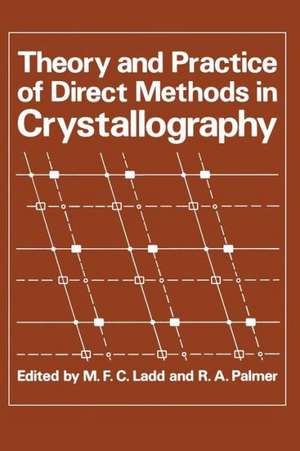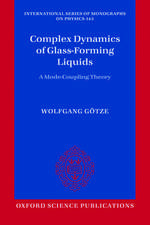Theory and Practice of Direct Methods in Crystallography
Autor M. F. C. Ladd, R. A. Palmeren Limba Engleză Paperback – 5 oct 2011
Preț: 396.24 lei
Nou
Puncte Express: 594
Preț estimativ în valută:
75.82€ • 79.53$ • 63.12£
75.82€ • 79.53$ • 63.12£
Carte tipărită la comandă
Livrare economică 01-15 aprilie
Preluare comenzi: 021 569.72.76
Specificații
ISBN-13: 9781461329817
ISBN-10: 1461329817
Pagini: 436
Ilustrații: 436 p. 4 illus.
Dimensiuni: 155 x 235 x 23 mm
Greutate: 0.61 kg
Ediția:1980
Editura: Springer Us
Colecția Springer
Locul publicării:New York, NY, United States
ISBN-10: 1461329817
Pagini: 436
Ilustrații: 436 p. 4 illus.
Dimensiuni: 155 x 235 x 23 mm
Greutate: 0.61 kg
Ediția:1980
Editura: Springer Us
Colecția Springer
Locul publicării:New York, NY, United States
Public țintă
ResearchCuprins
1. Principles of Direct Methods of Phase Determination in Crystal Structure Analysis.- 1.1. Introduction.- 1.2. Spherical Symmetry of Atoms: Sayre’s Equation.- 1.3. Unitary and Normalized Structure Factors.- 1.4. Karle-Hauptman Determinants.- 1.5. Structure Invariants and Seminvariants.- 1.6. Probability Theory.- 1.7. Solving the Phase Problem for a Real Structure.- 1.8. Refinement of Phases.- 1.9. Possible Future Developments of Direct Methods.- 2. Definition of Origin and Enantiomorph and Calculation of |E| Values.- I: Definition of Origin and Enantiomorph.- 2.1. Introduction.- 2.2. Some Preliminaries.- 2.3. Invariance.- 2.4. Variation of Phase among the Laue-Related Reflections.- 2.5. Defining the Origin.- 2.6. Some Unusual Requirements of S/I Selectors.- 2.7. In Conclusion.- II: Calculation of |E| Values.- 3. Symbolic Addition and Multisolution Methods.- 3.1. Introduction.- 3.2. Symbolic Addition: Centrosymmetric Case.- 3.3. Symbolic Addition: Noncentrosymmetric Case.- 3.4. Advantages and Disadvantages of Symbolic Addition.- 3.5. Multisolution Methods.- 3.6. Success Is Not Guaranteed.- 3.7. More Recent Developments of the Multisolution Method: Magic Integers.- 4. Probabilistic Theory of the Structure Seminvariants.- 4.1. Major Goal.- 4.2. Introduction.- 4.3. Structure Invariants.- 4.4. Structure Seminvariants.- 4.5. The Structure Seminvariants Link the Observed Magnitudes |E| with the Desired Phases ?.- 4.6. Probabilistic Background.- 4.7. Three-Phase Structure Invariant.- 4.8. Four-Phase Structure Invariant (Quartet).- 4.9. The Neighborhood Principle.- 4.10. More on Quartets: Higher Neighborhoods.- 4.11. Two-Phase Structure Seminvariants (Pairs).- 4.12. Concluding Remarks.- 5. Application of Calculated Cosine Invariants in Phase Determination.- 5.1.Introduction.- 5.2. Accuracy of Cosine Calculations.- 5.3. Quartets, Quintets, and Triplets.- 5.4. ?1 Cosines.- 5.5. Pair Relationships.- 5.6. Strong Enantiomorph Selection.- 5.7. NQEST.- 5.8. Automated Procedures.- 5.9. Exercises.- 6. Phase Correlation with Calculated Cosine Invariants for Routine Structure Analysis.- 6.1. Phase Correlation Procedure.- 6.2. Simple Cosine-Invariant Calculations.- 6.3. Phase Correlation with Calculated Triple Invariants.- 6.3.1. Centrosymmetric Space Groups.- 7. Application of Direct Methods to Difference Structure Factors.- 7.1. Introduction.- 7.2. Difference Structure Factors.- 7.3. Description of the Procedure.- 7.4. Some Observations.- 8. Phase Extension and Refinement Using Convolutional and Related Equation Systems.- 8.1. Introduction.- 8.2. Outline of the Convolutional Equation Systems.- 8.3. Outlines of the Phasing Methods Based on the Convolutional Equation Systems.- 8.4. Comments on the Phasing Methods Based on the Convolutional Equation Systems.- 8.5. Computational and Practical Aspects.- 8.6. Summary.- 9. Maximum Determinant Method.- 9.1. Introduction.- 9.2. Inequalities and Algebraic Properties of Determinants.- 9.3. Maximum Determinant Rule.- 9.4. Practical Applications.- 9.5. New Gram Determinants.- 10. Molecular Replacement Method.- 10.1. Introduction.- 10.2. Preliminary Theoretical Considerations.- 10.3. Rotation Function.- 10.4. Translation Problem.- 10.5. Phase Determination.- 10.6. Noncrystallographic Symmetry and Heavy-Atom Searches.- 10.7. Applications of Molecular Replacement.- 10.8. Conclusions.














